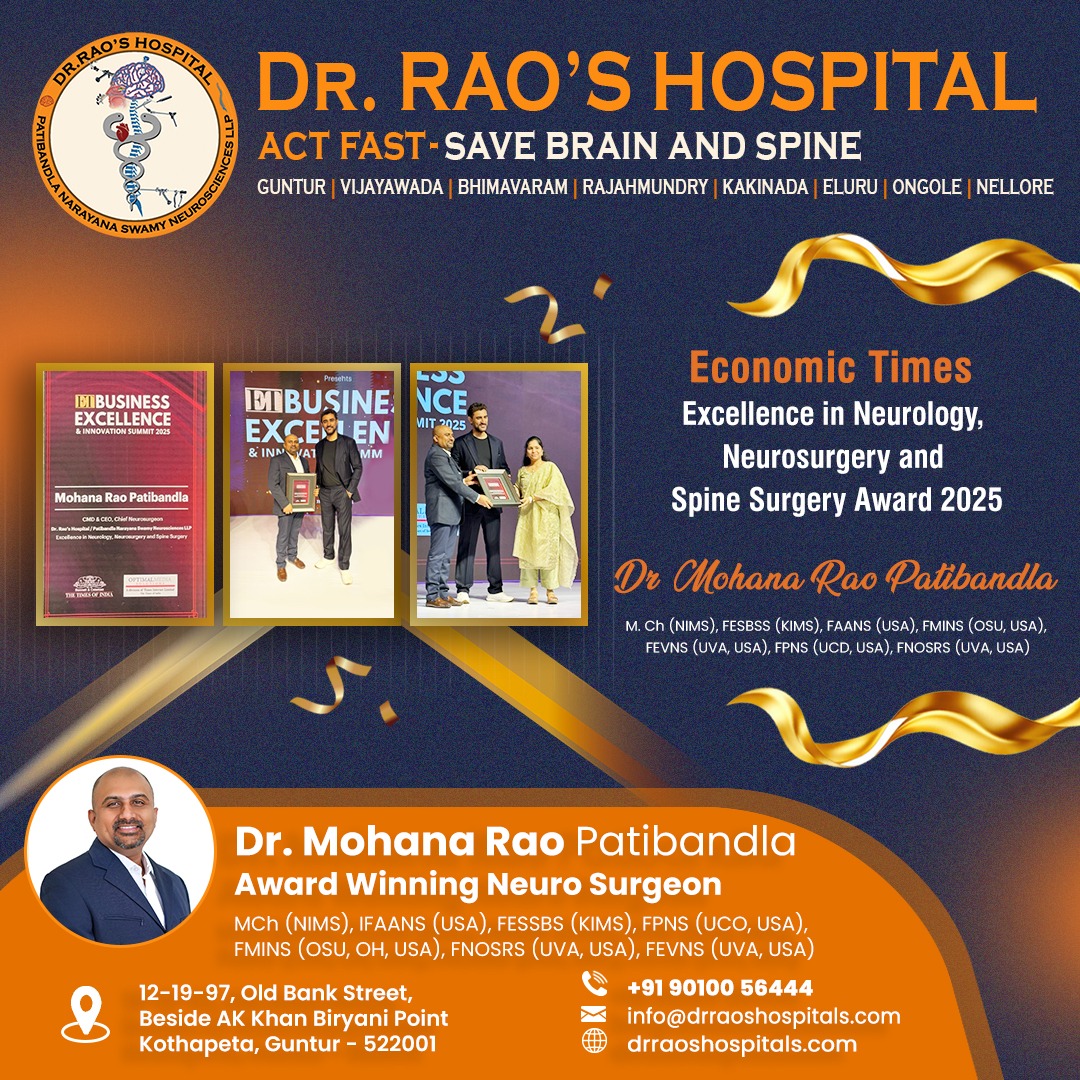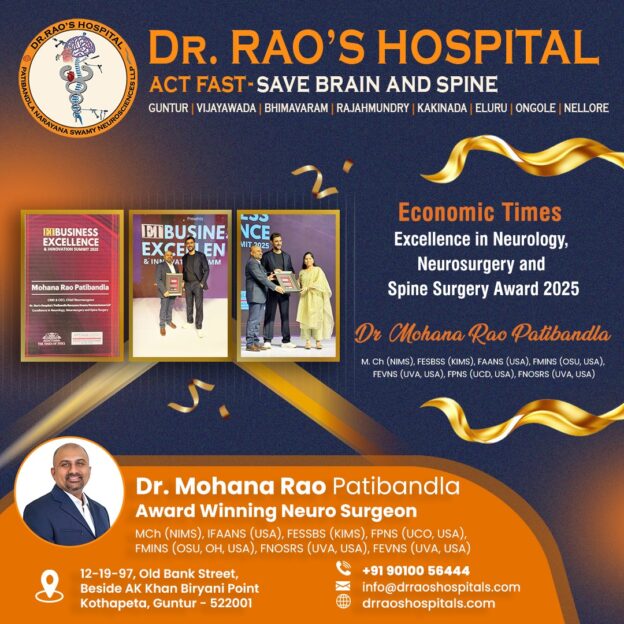Understanding Scoliosis of the Spine: Causes, Symptoms & Treatments
The human spine plays a crucial role in maintaining posture, balance, and overall body function. However, when the spine develops an abnormal curve, it can lead to a condition known as scoliosis of the spine. This spine curvature disorder affects millions worldwide, ranging from mild postural changes to severe spinal deformities that impact daily life.
At Dr. Rao’s Hospitals, expert orthopedic and spine specialists provide advanced diagnostic and therapeutic care to help patients manage and overcome scoliosis effectively.
What Is Scoliosis of the Spine?
Scoliosis of the spine is a condition in which the spine curves sideways, forming either an “S” or “C” shape. Unlike normal spinal curves that help balance the body, these abnormal curves can distort the posture, leading to uneven shoulders, hips, or ribcage alignment.
The disorder can develop in childhood or adolescence, though adults may also experience it due to degenerative spinal conditions or trauma. Understanding the underlying causes of scoliosis and recognizing early scoliosis symptoms are crucial for timely intervention.
Major Causes of Scoliosis
While the exact causes of scoliosis often remain unclear, several factors can contribute to its development:
- Idiopathic Scoliosis – The most common form, especially in adolescents, where no specific cause is identified. Genetics may play a role.
- Congenital Scoliosis – Present at birth due to malformed vertebrae or abnormal spinal development in the womb.
- Neuromuscular Scoliosis – Associated with conditions such as cerebral palsy or muscular dystrophy, where muscle imbalance leads to spinal curvature.
- Degenerative Scoliosis – Common among adults, caused by age-related spinal wear and tear, arthritis, or osteoporosis.
- Postural or Traumatic Scoliosis – May result from poor posture, leg length differences, or spinal injuries.
By identifying the causes of scoliosis early, doctors can recommend personalized care plans that prevent progression and manage pain effectively.
Recognizing the Common Scoliosis Symptoms
The scoliosis symptoms vary based on the severity of the curvature and the patient’s age. Some of the most noticeable signs include:
- Uneven shoulders or waist
- One hip higher than the other
- Visible curve in the spine
- Back pain or stiffness
- Fatigue after prolonged sitting or standing
- Difficulty breathing in severe cases
In children and teens, scoliosis symptoms are often painless and may only become apparent during growth spurts. Regular screening and physical examination are vital for early detection of this spine curvature disorder.
Diagnosis: How Doctors Identify Scoliosis
At Dr. Rao’s Hospitals, diagnosis of scoliosis of the spine begins with a detailed physical examination. The physician evaluates spinal alignment, shoulder level, and hip symmetry.
Advanced imaging techniques, including X-rays, MRI, and CT scans, help measure the curvature’s angle—known as the Cobb angle—which determines the severity and guides the selection of scoliosis treatment options.
Timely diagnosis ensures that the condition does not progress into a more painful or functionally limiting stage.
Scoliosis Treatment Options
The choice of scoliosis treatment options depends on the patient’s age, the degree of spinal curvature, and the cause of the condition. Common treatments include:
1. Observation and Monitoring
For mild curves, regular monitoring helps track any progression. Children may require frequent checkups during growth phases.
2. Bracing
Bracing is often recommended for adolescents with moderate curvature to prevent worsening. It does not correct the existing curve but helps control further deviation.
3. Physical Therapy
Targeted exercises improve posture, muscle balance, and flexibility. Techniques such as the Schroth Method are particularly effective for managing spine curvature disorder.
4. Surgical Intervention
In severe cases, surgery—most commonly spinal fusion—is considered the best treatment for scoliosis. It straightens and stabilizes the spine using rods and screws, preventing further curvature.
For patients seeking the best spine fusion hospitals in India, Dr. Rao’s Hospitals provides world-class care and minimally invasive procedures for optimal recovery. Patients traveling internationally can also explore medical tourism options to access advanced spine care at affordable rates.
5. Lifestyle and Supportive Care
Pain management, ergonomic adjustments, and maintaining a healthy weight are crucial supportive measures that complement medical treatment. If you are looking for the best spine surgeon in Andhra Pradesh or a skilled spine surgeon in Visakhapatnam, Dr. Rao’s team offers personalized guidance and treatment plans.
Living with a Spine Curvature Disorder
Adjusting to life with scoliosis of the spine requires both physical and emotional adaptation. Patients benefit from:
- Regular follow-ups to monitor progress
- Physical therapy to maintain flexibility
- Nutritional support for bone health
- Psychological counseling to manage self-esteem issues caused by visible spinal deformity
Support groups and awareness programs at Dr. Rao’s Hospitals encourage patients to stay motivated and informed throughout their treatment journey.
Prevention and Early Intervention
Although not all causes of scoliosis can be prevented, early screening plays a key role. Parents should look for warning signs such as uneven shoulders or tilted posture in their children.
Routine school checkups and awareness of scoliosis symptoms help ensure that any spine curvature disorder is identified early, increasing the success rate of conservative treatments.
Conclusion
Scoliosis of the spine is a complex but manageable condition when addressed early. By understanding the causes of scoliosis, recognizing scoliosis symptoms, and exploring the right scoliosis treatment options, patients can lead active, pain-free lives.
Whether you need advanced diagnostics, physiotherapy, or surgical expertise, Dr. Rao’s Hospitals offers the best treatment for scoliosis through personalized care and modern medical technology.
For patients seeking the best spine fusion hospitals in India, or the expertise of the best spine surgeon in Andhra Pradesh and spine surgeon in Visakhapatnam, Dr. Rao’s Hospitals provides world-class treatment and facilities. Medical tourism patients are welcomed with tailored support to ensure a seamless treatment journey.
Your spine health deserves the best—trust Dr. Rao’s Hospitals to help you stand tall and confident again.
Frequently Asked Questions
- What is scoliosis of the spine?
Scoliosis of the spine is a sideways curvature that can affect posture, balance, and overall body alignment. It’s often detected during adolescence but can appear in adults too. - What are the main causes of scoliosis?
The causes of scoliosis include genetic factors, birth defects, neuromuscular diseases, and age-related degeneration. In many cases, the cause remains unknown (idiopathic scoliosis). - What are the early scoliosis symptoms I should look out for?
Common scoliosis symptoms include uneven shoulders, visible spinal curve, back pain, and one hip appearing higher than the other. - Can scoliosis cause back pain?
Yes. While mild scoliosis may not cause pain, severe curvature can strain muscles, compress nerves, and lead to chronic discomfort. - What are the available scoliosis treatment options?
Scoliosis treatment options include observation, bracing, physiotherapy, and surgery depending on the degree of curvature and patient age. - What is the best treatment for scoliosis in adults?
For adults, the best treatment for scoliosis often includes physical therapy and, in advanced cases, corrective surgery to stabilize the spine. - Is scoliosis of the spine a permanent condition?
Mild scoliosis can be managed effectively, but severe cases may require lifelong care to maintain spinal balance and function. - Can exercise improve scoliosis?
Yes. Specific exercises, like the Schroth method, strengthen muscles, improve posture, and support better spine alignment. - How can I prevent scoliosis from worsening?
Early diagnosis, consistent therapy, proper posture, and regular medical follow-ups help prevent progression of the spinal curve. - Where can I find the best treatment for scoliosis in India?
You can visit Dr. Rao’s Hospitals, where expert orthopedic specialists offer comprehensive scoliosis care, from diagnosis to rehabilitation.


